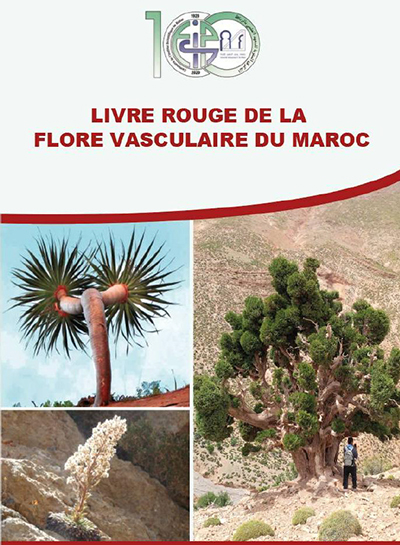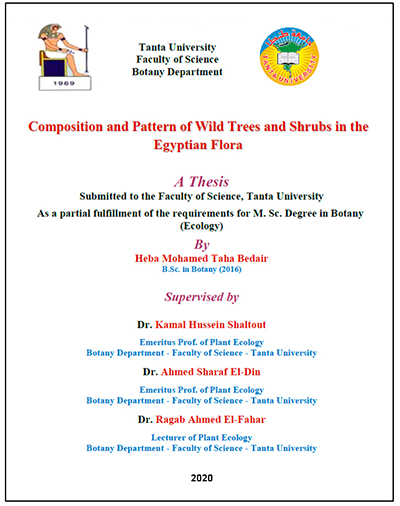Publications on the biodiversity of North Africa are becoming more common and of better scientific quality. On this occasion we will talk about two of them, about flora, really important, both from collaborators of this website. A new Red Book and a M. Sc. thesis that is complemented by a recent article published in the African Journal of Ecology.
Fennane, M. 2021. Livre rouge de la flore vasculaire du Maroc. Travaux de l’Institut Scientifique, Série Botanique, n° spécial Premier centenaire de l’Institut Scientifique. Rabat. 750 pp.

The knowledge of the flora of Morocco has several important milestones throughout the last century and, more especially, in the last two decades. Probably the most important was the publication of the 3 volumes of Flore pratique du Maroc (Fennane, Ibn Tattou, Ouyahya, El Oualidi & Mathez, ed., 1999-2014). In this work, based on dichotomous keys, it was finally possible to quantify and differentiate, for the first time, all the known flora of the country. But much of this flora is threatened by the great changes that Morocco is experiencing precisely throughout this last century. Aware of this, the Kingdom of Morocco approved in 2011 Law 29-05 related to the protection of wild flora and fauna species and the control of their trade, then, in 2015, the decree for its application.
In the second decade of the 21st century, the diversity and taxonomy of the Moroccan flora was already well known and legislation was passed for the protection of some threatened species. But the real state of conservation of this diverse flora (some 4,000 species) remained to be known. To solve this enigma, Mohamed Fennane, from the Institut Scientifique, with the support of a great team of national and foreign botanists, got down to work and between 2016 and 2018 published the “Eléments pour un livre rouge de la flore vasculaire du Maroc” on the Tela Botanica website, in a series of 10 fascicles.
With this, the first Red List was published at the national level. But a little later, in 2021, Fennane and his team of botanists published a second revised version in a single volume, the Livre rouge de la flore vasculaire du Maroc. A very complete and expected book, based on the current IUCN criteria and categories. Its great value is that it not only deals with endangered species, but also includes all species in the country. Undoubtedly, this book will not only serve to find out the level of threat of each species, but it is also a first-rate tool on which to base policies and other initiatives for the conservation of the rich flora of Morocco.
The book can be obtained by writing to: edition.israbat@gmail.com ou direction.institutscientifique@gmail.com
Bedair, H. (2020). Composition and pattern of wild trees and shrubs in the Egyptian flora. M. Sc. Thesis. Botany Department, Faculty of Science, Tanta University. 290 pp.

Throughout this thesis Heba Bedair studies 228 taxa of woody species native to Egypt (32 trees, 192 shrubs, 2 lianas and 2 hemiparasitic species). Far from the sometimes excessive technicalities of other theses, this one is pleasant to read even with the scientific rigor it contains. Throughout its almost 300 pages, the author exposes the distribution of this flora in families and genera, according to the different habitats of the country, according to its size, its flowering periods, its forms of sexual reproduction or the goods and services that these trees and shrubs contribute to society. Among her conclusions, she shows that the Egyptian deserts contain the greatest wealth of woody species.
But this wealth is being greatly threatened. 100% of the species are subject to some type of threat. The most serious of all is overgrazing, but the one that affects the most species is over-collecting and over-cutting for very diverse uses, but among which the over-collecting of plants for medicinal purposes stands out. As a consequence of these and other threats, of the 228 taxa analyzed, 3 taxa are extinct, 2 taxa are extinct in the wild, while 101 taxa of the total trees and shrubs are threatened with extinction; 25 taxa are critically endangered, 52 taxa are endangered and 24 taxa are vulnerable.
20 years earlier El-Hadidi et al. (2002) have already sounded the alarm about the tragic situation of native trees and shrubs in the country, crying out to national (NCS, EPAN) and international (IUCN, UNEP, WWF) organizations. But the situation, far from improving, continues to worsen. Over-grazing, over-collecting and over-cutting, irresponsible tourism development, land encroachment, a very serious problem with water (pollution and over-use), direct destruction of vegetation, and other threats sometimes exist even within protected areas.
Updates to this thesis conclude that, among other concerns, 61% of Egypt’s native tree species are near extinction. It can be seen in a recent article just published (2022) on tree species:
Shaltout, K. & Bedair, H. 2022. Diversity, distribution and regional conservation status of the Egyptian tree flora. African Journal of Ecology, 00: 1-29. DOI: 10.1111/aje.13071
